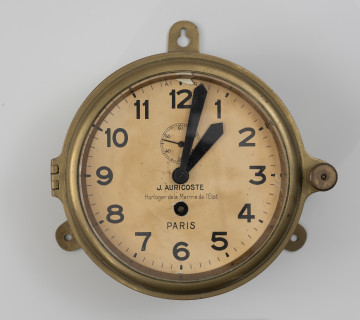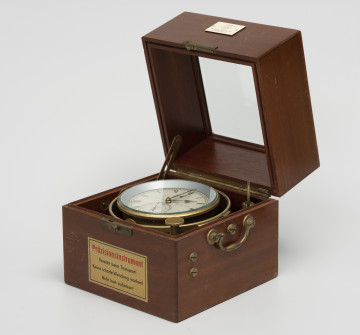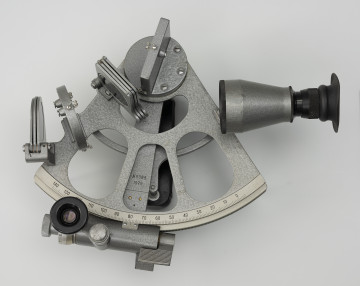
Ship clock
1901 — 1950
National Museum in Szczecin
Part of the collection: Equipment of watercrafts
Ship clocks, also known as chronometers, were used to govern shipboard life, but were primarily used in navigation. Hence, they had to be impervious to temperature changes, and their airtight fitting was designed to protect them from moisture. They were mainly placed in the chart cabin, on the platform, wheelhouse or later in the engine room and on piers. They have now been superseded by electronic clocks and satellite navigation. Ship's clocks, such as the one featured, were manufactured during the Second World War by the American Chelsea Clock Company and were most commonly fitted on Liberty ships. Chelsea is a town in Suffolk County, Massachusetts, which is separated from Boston by the Mystic River and where, in 1897, Charles Pearson began manufacturing clocks under a new name, the Chelsea Clock Company, after taking over the Boston Clock Company. In 1900, the company also patented the first mechanism for ship clocks, and US government agencies quickly became interested in buying them. In addition to new solutions for ships, Chelsea also offered appliances for cars and, in 1917, its first solutions for aviation. The 1930s saw a decline despite orders from the US Navy, and it was only through government orders for the army during the Second World War that the company's income would be boosted, and in 1943 it was awarded the Government Prize for Excellence in Manufacturing. Today, after more than a century in business, Chelsea clocks may not only be found on US Navy ships or in the White House, but also in homes and offices around the world. Leszek Kocela
Author / creator
Object type
chronometer, watercraft equipment
Technique
batch production
Material
plastic, metal, glass, ebonite
Origin / acquisition method
purchase
Creation time / dating
Creation / finding place
Owner
Muzeum Narodowe Szczecin
Identification number
Location / status

1901 — 1950
National Museum in Szczecin

1901 — 1950
National Museum in Szczecin

circa 1976
National Museum in Szczecin
DISCOVER this TOPIC
National Museum in Szczecin
DISCOVER this PATH
Educational path